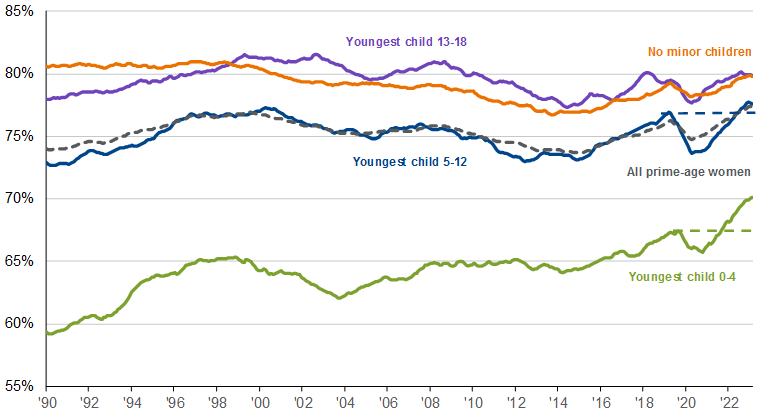Written by: Stephanie Aliaga
In an economic expansion that has continually surpassed market and Fed expectations, women have been at the forefront. More women are working than ever before.
The pandemic was very tough on women, even earning the nickname “she-cession”[1], with a striking 13.6 million women (18% of the female population) losing their jobs during the depths of the pandemic. Many women were initially held back in the recovery due to heightened responsibilities of child and elderly care, but women have regained their economic footing and are breaking new ground. The labor force participation rate for women aged 24-54 reached an all-time high of 77.8% in September 2023 and has hovered near those levels since.
Coming out of the pandemic, the reopening of schools and widespread vaccine distribution provided major relief to women, who are 7-8x more likely to have employment affected by caregiving responsibilities.[2] Beyond fading pandemic effects, meaningful shifts in the economy have supported female employment.
- Labor demand has been particularly strong in female-dominated sectors. Women account for 78% of employment in the health care and social assistance sector, 71% in educational services and 55% in leisure and hospitality—together accounting for nearly 40% of remaining private sector job openings.[3]
- Access to childcare has improved: After acute shortages and soaring costs of childcare during the pandemic, strong fiscal supports and hiring have helped ease this gap. Employment in childcare centers recovered to pre-pandemic levels last April and wage growth has fallen from a peak of 12% y/y to 3.9% y/y in December 2023, helping costs moderate.
- Work-from-home has made it easier for mothers to stay in the labor force. Surveys show mothers strongly prefer a flexible or remote work schedule[4] and one study found that a 1%-point increase in work-from-home was associated with a 1.2%-point narrowing of the “motherhood employment gap” amongst college-educated women, with gains most pronounced in finance, business, and communications fields[5].
Within this upward trend in female participation is one cohort seeing outsized gains: mothers of young children. Women with a child under the age of 5 are among the least likely to be in the labor force and now boast a 70% participation rate, well beyond pre-pandemic levels. Further analysis of this cohort finds that college-educated mothers and foreign-born mothers account for the strongest gains[6]. Progress remains vulnerable as major fiscal support for childcare lapsed last September and return-to-office measures could constrain flexibility.
Overall, it’s a pretty good time to be a working woman. Not only have women been welcomed back to work with tight labor market conditions, but they’ve also made strides in income and wealth generation. Women are now either the primary breadwinner or contribute as much as their spouse in nearly half of U.S. opposite-sex marriages[7]. In the midst of a massive inter-generational wealth transfer, women are expected to control much of the $30 trillion in financial assets baby boomers will possess by 2030[8]. The financial future for women looks promising, but for individual investors, a strong financial plan will be key in seizing the opportunity.
Prime-age women's labor force participation, by age of youngest child
12-month rolling average, women aged 25-54 years

Source: Bureau of Labor Statistics, Census Microdata, Brookings Institution, J.P. Morgan Asset Management. Data from Jan. 1990 to Sept. 2023 provided by Brookings and data from Oct. 2023 to Jan. 2024 has been estimated by J.P. Morgan Asset Management from BLS data. Data are as of March 7, 2024.
Related: The Federal Reserve's Actions During Election Years
[1] Bluedorn et. al, “Gender and Employment in the COVID-19 Recession: Evidence on “She-cessions”, March 2021.
[2]Census Bureau, 2022. Data reflects the share of prime-age women relative to prime-age men citing a caregiving impact on employment.
[3]Bureau of Labor Statistics. JOLTS report on job openings as of January 2024.
[4] Bankrate, August 2023.
[5]Emma Harrington and Matthew Kahn, “Has the Rise of Work-from-Home Reduced the Motherhood Penalty in the Labor Market?”, 2023. Harrington and Kahn analyzed the impact of WFH in the decade before the pandemic on college-educated workers. On average, a 1%-point increase in the share of workers primarily working from home (which averaged 6% during the period) was associated with a 1.2%-point increase in the employment of mothers relative to other women.
[6]Brookings Institution, “Prime-age women are going above and beyond in the labor market recovery,” August 2023.
[7]Pew Research Center, “In a Growing Share of U.S. Marriages, Husbands and Wives Earn About the Same,” April 2023.
[8]McKinsey & Company, “Women as the next wave of growth in US wealth management,” July 2020.


